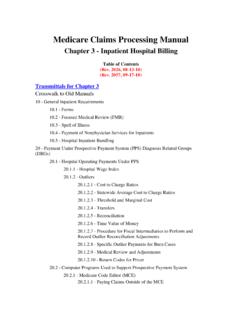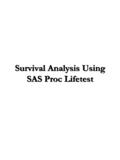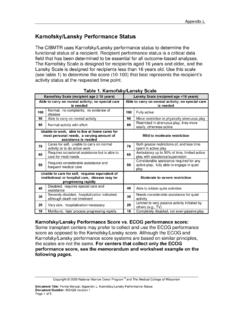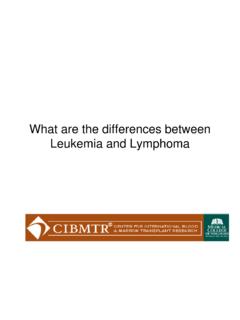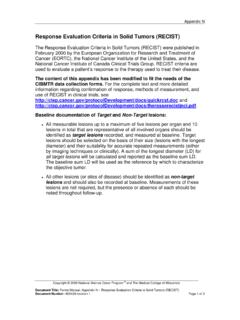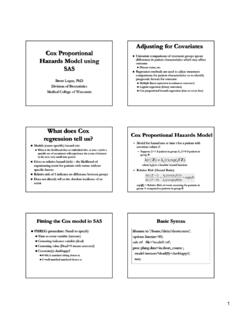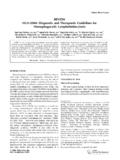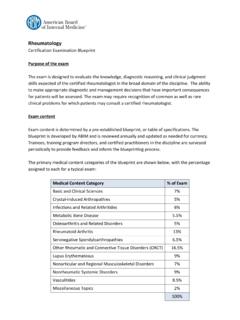Transcription of Epstein-Barr Virus (EBV) complications following …
1 Epstein-Barr Virus (EBV) complications following HSCT:from viremia to post transplant lymphoproliferativeppyppdisease (PTLD) and lymphomaLaurie A. Milner, MDLaurie A. Milner, MDAssociate Professor,Pediatric Hematology / Oncology / HSCTP ediatric Hematology / Oncology / HSCTP athology and Laboratory MedicineMedical Oncology and the Wilmot Cancer CenterMedical Director, Stem Cell Processing LaboratorygyUniversity of Rochester Medical CenterFebruary 12, 2009 No conflicts of interest or financial disclosuresDiseases Associated with EBV1. Mononucleosis2. Burkitt Lymphoma3. Nasopharyngeal carcinoma4.
2 Hemophagocytic lymphohistiocytosis (HLH)5. lymphoproliferative Syndromes, Juvenile Myelomonocytic Leukemia (JMML)Juvenile Myelomonocytic Leukemia (JMML)Post- transplant lymphoproliferative disease (PTLD) Epstein Barr Virus : aka EBV or HHV-41. Herpes virus2. Once you ve had have it forever ( Virus becomes latent in memory B cells)(y)BB3. Expansion of infected B cells is controlled by CD 8+cytotoxic T cells (CTL)by CD 8cytotoxic T cells (CTL) and NK/LAK cellsBTTBTTEBV Infection Post-HSCT1 Viral ReactivationBB2. T cell immunosuppressionTTTBT3. Expansion of infected B cellsBBBBBBBBBBC linical Manifestations of EBV Infection1.
3 Asymptomaticyp2. Fever3. Tonsillar enlargement4. Lymphadenopathy5. Hepatosplenomegaly6 Bowel obstruction7. Respiratory symptoms due to pulmonaryinfiltration or airway compressioninfiltration or airway compression8. B symptoms: sweats, weight loss9. CNS symptoms10. Cytopenias due to BM involvementSpectrum of EBV infections in the immunocompetent hostimmunocompetent hostAsymptomaticCommon(Fever, LAD, HSM, Fatigue)MononucleosisChronic EBV InfectionRareLymphoproliferative syndromesRareLymphoproliferative syndromesHLH, MalignanciesSpectrum of EBV infections in the immunocompromised hostimmunocompromised hostCtti Rti ti CommonNonspecificasymptomatic Reactivation Nonspecific (fever, rash, fatigue)
4 Viremiafocal ordisseminatedPTLDHLH disseminatedlhPTLDM alignancieslymphomaleukemiaUncommonNatur al history of EBV infections in the immunocompromised hostimmunocompromised hostlow copy numberspontaneous Reactivation low copy number(viral genome)spontaneousresolutionReactivation rapidViremiahigh copy numberrapid progressionPTLDHLH high cop n mberPTLD high copy number& cellular proliferationFatalMalignancyFatal (~90% MR)Development of EBV-associated PTLD requires:1. EBV reactivation2. T cell suppressionT3 Presence of B cells3. Presence of B cellsBBBBBBBBBBBBF actors that influence the development of PTLD 1.
5 EBV reactivation Serologic status of donor and recipient2 T cell suppressiongp Age: children > adults2. T cell suppression T cell depletion of the stem cell product Tll dit d iif thtit T cell directed immunosuppression of the patient- especially antibody therapy: ATG, OKT3, -CD33. Presence of B cells Stem cell product - early PTLD (< 1 year) almostalways involves proliferation of donorB cells Cell doseEBV infections post HSCT: therapeutic options1 VirusTargetAgentsResponseAntiviral drugsMixed (not usually sufficient)2. B cellsVery good (if used early)Rituximab( -CD20 MoAb)3.
6 T cellschemotherapyanecdotal responsesDiscontinue3. T cellsDonor Lymphocyte Infusions (DLI)immunosuppressionMixed(limited by GVHD)EBV specific cytotoxic T cells (CTL)Infusions (DLI)Very good (if available)Monitoring HSCT patients for EBV infection/PTLDPre-transplantPost-transpl antppClinical symptomsgenerally not helpful(non-specific too late)helpful (postpone transplant )Serologieshelpful toNOThlflsymptoms(non-specific, too late)(postpone transplant )Serologies(recipient and donor)helpful to assess risk of reactivation NOT helpfulQuantitativemay be helpful inHelpful(if done correctlyPCR for viral DNAspecific cases(if done correctly& standardized))
7 Studies using Q-PCR to evaluate EBV viremia &PTLD have been limited by numerous factorsy Relatively low incidence of PTLD unrecognized and unreported cases unrecognized and unreported cases Single institution and retrospective analyses few cases in any given study Chit hlit d t t ii Single institution and retrospective analyses variable treatment regimens & patient populations Changing technologies to detect viremia lack of standardization and variable sensitivity use of different patient samples & unit basis Evolving transplant regimens and the use of new immunosuppressive agents use of different patient samples & unit basisnew immunosuppressive agents especially the increasing use of reduced intensity (RIC) and nonmyeloablative (NMA) regimensDespite the complicating factors, Q-PCR studies have led to important insights into the incidence and risk factors for EBV viremia & PTLD following HSCTTh fll ilidtbi ddt fThe following slides represent combined data from multiple studies; they are intended to illustrate trends and consensus observationstrends and consensus observations.
8 Variable patient populations transplantVariable patient populations, transplant regimens, and other factors unique to each study preclude direct comparisons in most of EBV Viremia & PTLD post HSCTType of HSCTV iremiaPTLDM yeloablativeMyeloablative< 1%MUDM atched sib8-10%25-30%4-6%MUD 2530%46%NonmyeloablativeUCB 2-5%Non-myeloablativeor reduced intensity30-50%10-15% The increased incidence of EBV reactivation and PTLD in NMA/RIC transplants is likely due to the highlyImmunosuppressive regimens employed, particularly Fludarabine + ATGI ncidence of EBV PTLD post UCBT Low incidence of EBV reactivation & PTLD with UCBT reflects the lower numbers of mature lymphocytes& decreased probability of EBV in the product& decreased probability of EBV in the product However, UCB recipients treated with NMA/RIC regimensth t i l d ATGt iifit i k fPTLD that include ATG are at significant risk for PTLDM yeloablativeBrunstein.
9 Blood. 20065/240 (2%)6/95 (7%)Non-myeloablative1/65 (1 5%)without ATGwith ATG5/30 (17%)1/65 ( )without ATGI mpact of T cell depletion on EBV Viremia & PTLDEx vivotreatmentViremiaPTLDU nmanipulated graft2530%05%Unmanipulated graftT cell depleted graft25-30%30-65%0-5%10-20%risk depends on method of depletion: highest risk with ATG, -T cell Abslower with Campath, CD34 selection1525%in vivoT cell depletion5065%p,In vivotreatment15-25%17%in vivoT cell depletion (ATG, OKT3, -CD3)iiT&B lld l ti50-65%15%1-7%in vivoT & B cell depletion (Campath)15%Cohen, Leukemia & Lymphoma.
10 2007 ViremiaPTLDP ediatric PatientsViremiaPTLDC onditioning RegimenReduced Intensity (RIC)Conventional (myeloablative) (myeloablative) 9%In vivoT-cell depletionATG0%11 6% OthersAcute the natural history of EBV infections in HSCT patientsinfections in HSCT patientslow copy numbert Rti ti low copy number(viral genome)spontaneousresolution Reactivation progressionViremiahigh copy numbermonitoringprogressionPTLDHLH high copy numberpreemptive orprompt therapyPTLD high copy number& cellular proliferationprompt therapyfatalMalignancy& cellular proliferationUsing Q-PCR to predict progression of viremia to PTLDVan Esser, Blood.
